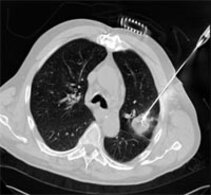Tumor Ablation
Interventional radiology and treatment
Radiofrequency ablation
Radiofrequency ablation of malignant tumors is a novel and very efficient minimally invasive therapeutic concept. The Department of Radiology performed CT-guided radiofrequency treatment of bronchial carcinoma, lung metastases, renal carcinoma, liver carcinoma and liver metastases.
Before treatment, the options will be thoroughly discussed with you on the basis of your medical history.

After local anaesthesia and disinfection, a special needle electrode with a diameter of only 1.8 mm will be inserted into the tumor through the skin under CT guidance. This is absolutely painless, as you will receive pain medication via an intravenous line in addition.
Through the electrodes, an electric current is delivered which heats the tissue around the electrodes to a temperature of 90° to 100° Celsius. Again this is absolutely painless.
At the end of the treatment session, the electrodes are pulled back into the needle and the system is removed from the body. A bandage will be applied and you will be carefully monitored on the ward until the next morning.
Microwave ablation
The new treatment method of microwave ablation destroys cancer cells with the help of heat created by microwave energy. After performing a CT Scan and localizing the tumor, we place a thin antenna directly inside of it. Once properly positioned, the antenna generates 60 degree Celsius heat to destroy the tumor cells.
Microwave ablation is ideally used for tumors less than 3 cm in diameter, in some cases up to 5 cm.